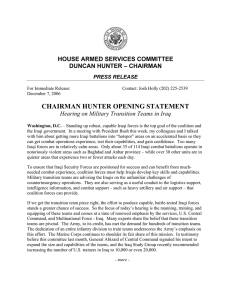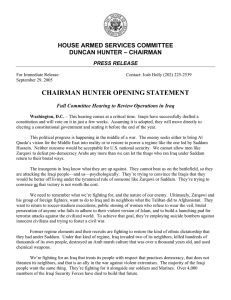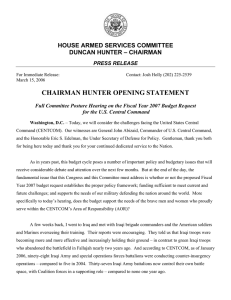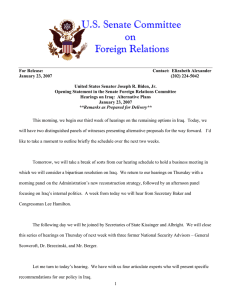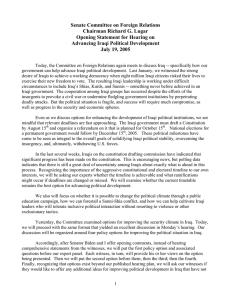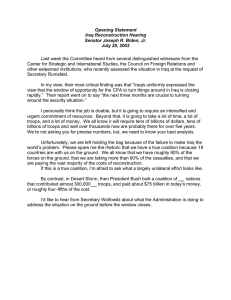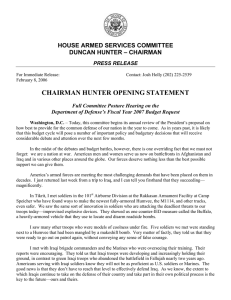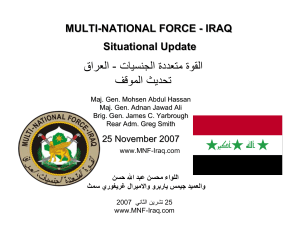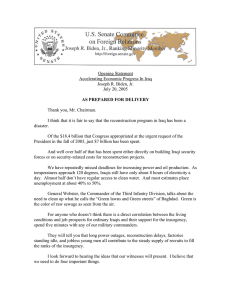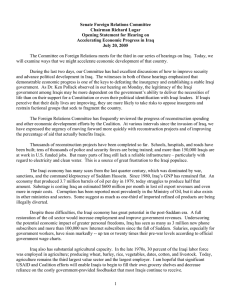Nation Building in Iraq: A Status Report CSIS
advertisement
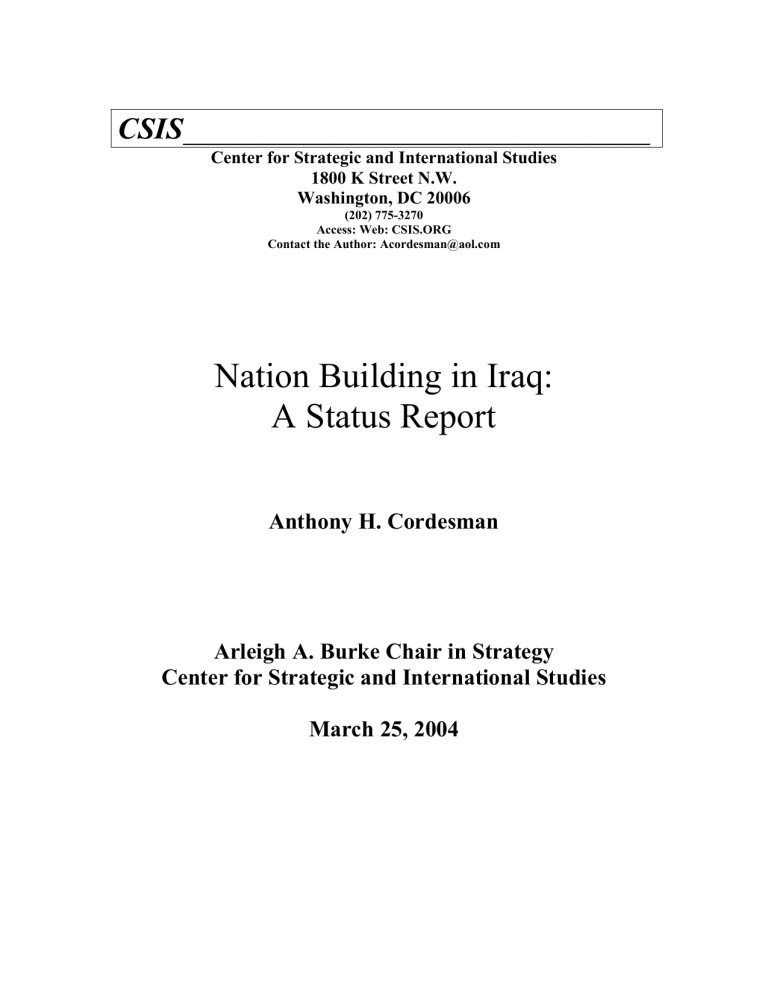
CSIS_______________________________ Center for Strategic and International Studies 1800 K Street N.W. Washington, DC 20006 (202) 775-3270 Access: Web: CSIS.ORG Contact the Author: Acordesman@aol.com Nation Building in Iraq: A Status Report Anthony H. Cordesman Arleigh A. Burke Chair in Strategy Center for Strategic and International Studies March 25, 2004 It is always tempting to view Iraq in military terms, or in terms of the latest political crisis. In practice, however, what will happen in Iraq is dependent on a complex set of variables that will play out over a period of years. These include: • Who comes to control oil revenues and aid money in the short run, and the process of oil exploration and development in the mid and long-term? • Who controls the Iraqi armed forces and security services, and defines the role of the US and Coalition military forces? • Who controls the process for determining the coming election, census, and media necessary to acquire political visibility? • What is the future of the Kurds, where the issue is not simply power in the classic sense, but the need to absorb a mini state that has existed for 10 years, done most of its teaching in Kurdish, and is still squeezing Arabs and minorities out of the region? • Who has control of the Shi'ite movement, where Ayatollah Ali Sistani faces a power struggle as the issue moves towards elections and the emergence of new Shi'ite leaders? • Who controls Iraq's 37(23?) ministries, 18 governates, and urban governments? • Who controls the process for determining who will draft the final constitution and then the approval of the resulting document? • What happens to the members of the Governing Council, and the more unpopular “exiles?” Where do secular Shi'ite leaders come from? Sunni leaders? • Who defines the future role of the US and UN? • How are the insurgents and firmly anti-new government Sunnis dealt with? As yet, no one has clear answers to any of these questions. Given the fact that at least initial answers must be found by the time an elected government takes over in 2005, it is a good idea to examine Iraq in a broader and longer-term context. Key Political Milestones (As of March 18, 2004) The political side of nation building in Iraq is still too uncertain to predict. The risk of confessional struggles between Sunni and Shi’ite is obvious, as is the risk of some form of power struggle between Arab and Kurd. The role of Islam in the state also remains undefined and could become a serious issue. At the same time, Iraqis have so far shown that are fully aware of the risks of such divisions, and are willing to compromise to avoid them. The Iraqi interim constitution is a good example of this. Five of the Governing Council’s Shias originally refused to sign the document, citing their belief that it gave the Kurds the ability to block changes the constitution. These members fear that the Kurds will thwart all attempts to limit their federal autonomy enshrined in the current version of the constitution. Despite these concerns, the five Shias eventually signed the document, reminding the council of its interim status. The seeds of tension exist, but the fact that the political side of nation building does not proceed smoothly does not mean that Iraqis cannot work out their differences over time. In fact, some form of political turbulence, and at least some incidents of low-level violence, are inevitable. No rival leader or political party has been allowed to function since Saddam’s bloody purge of his rivals in 1979. Religious leaders have no open political experience for the same reason. Aside from a few figures like Sistani, no leader has had broad political visibility or a broad popular base. Even basic governance has been precluded by Saddam’s insistence on tight control from the top and refusal to delegate functional authority. Saddam’s legacy is essentially a political and administrative vacuum and Iraqis have to feel their way towards a modern political system under extraordinarily difficult circumstances. Nevertheless, the calendar for major milestones in Iraqi nation building is tentative and highly unstable. It will ultimately depend on the Iraqis, and particularly on how well they work together in creating a new government. The Department of Defense currently project the following dates: 2004 March 8 Transitional Administrative Law signed March 26 CPA will create a new Iraqi Ministry of Defense and a cabinetlevel National Security Committee April 1 Establishment of Election Commission (approximate date) April 15 Annex to TAL released describing selection process and powers of Interim Government (approximate date) May 30 Selection of Interim Government (approximate date) Phase I (Interim Government) June 30 Iraq Interim Government Takes Power US Embassy replaces CPA; Coalition Provisional Authority will cease to exist July 30 New Iraqi government becomes fully operational January 31 Elections for the National Assembly complete: January 31, 2005 (December 31, 2004 if possible) 2005 No later than January 31 At the same time, all Iraqi voters will elect governate councils— again not later than January 31, 2005 Phase II (Elected Government) Early 2005 – Iraqi Transitional Government takes power Legislative: National Assembly • 275 elected officials • Electoral law will aim to achieve at least one-quarter women and fair representation of all communities in Iraq – Executive: Presidency Council, Council of Ministers, Prime Minister • President and two Deputies elected by National Assembly • Presidency Council appoints Prime Minister and Council of Ministers • Prime Minister responsible for day-to-day government management – Judicial Authority • Higher Juridical Council will supervise federal judiciary • Federal Supreme Court – 9 members nominated by Higher Juridical Council and appointed by Presidency Council August 15 National Assembly completes draft of permanent constitution October 15 Referendum for constitution--a constitution written by the National Assembly must be presented to the people in a general referendum no later than October 15, 2005 December 15 Elections for permanent government completed--a government elected under the terms of the new constitution, must be held no later than December 15, 2005--this fourth election will bring a directly elected government to power in Iraq December 31 Permanent government assumes office At a minimum, every one of these dates must involve major changes in the role of Iraqis in governing themselves, as well as some form of Iraqi struggle for power on a personal and factional level. Most dates involve serious changes in the role of the US and Coalition in unpredictable ways that will increasingly be defined by Iraqis – rather than Americans. Many could involve significant changes in the role of the UN and other powers. Polls like the ABC poll indicate that Iraqis are relatively optimistic about political progress and avoiding civil conflict. At the same time, such polls show that no secular leader has emerged with great support, and that the Governing Council lacks popularity. New Iraqi leaders are certain to emerge during this process, but no charismatic secular leader has yet emerged, and the timeline for such emergence is – to say the least – tight. Equally importantly, any such leaders can only emerge in an Iraq with half-formed political parties, without experience in leadership at a national level and in making practical compromises with other leaders, and having to govern untried institutions that the calendar shows will be in a constant state of change and turmoil. Two key issues are whether the members of the Governing Council can hold on out of sheer momentum, and who – if any one – will replace Sistani as a leading figure once the Shi’ites need a direct political leader. Moreover, the Department of Defense calendar only shows some of the milestones that must take place. • Courts and legal systems have to be put in play. • Iraq has to take over control of the security mission from the US and over the reshaping of its military and security forces. • Some 37 ministerial bodies in the central government have to be brought under full control. • Iraq has to take over full control of the efforts to modernize and rehabilitate the petroleum industry, industry, the financial sector, agriculture, and national media and communications. • Elected bodies must be established to deal with the 18 governates and local and urban governments. Equally important from the US perspective, there will be massive turnover in US personnel when the CPA is dissolved and the new US embassy takes over. This will interact with a similar turnover in US military personnel, and compound the problems created by so many short tours, a lack of language and area expertise, and sudden changes in personal contacts and relationships in a society where personal trust and relations are critical. Some of this turnover may help correct the fact that the Bush Administration seems to have deliberately chosen so many people for the CPA whose experience was largely in domestic US affairs, who lacked area expertise, and who tried to substitute ideology for pragmatism. At the same time, there is no pool of US area experts who really have any experience with Iraq, or with the problems of trying to convert a dictatorship and command economy into a modern society. Language skills and multiculturalism do not make a “nation builder,” and most of the new personnel for the embassy will have limited language skills – if any – and little practical working experience with Iraqi society. The US badly needs long service personnel who will stay in place and have time to build on their experience. At least during 2004, this is precisely what it will lack at every level. The Interim Law also leaves critical issues hanging, and the US does not know: • What the future role of the new Embassy will be in dealing with the new government, the ministries, governates, and local government. • What kind of military command and interface with the Iraqi security forces it can maintain over time, and what its role will be in shaping the future structure of the Iraqi military forces. • How nationalistic and religious the Iraq government will become over time. • How its plans for economic aid will interface with the plans of the new government, how the new government will treat the management of aid contractors, and how the government will view the present contractor use of private security forces. Key Development Issues One needs to be careful about criticizing the progress of economic development in Iraq. Far too often, the task is described as reconstruction. This simply is not the case. From the early 1970s on, Iraq invested primarily in guns and in butter only on a secondary level. It never took effective steps towards agricultural reform; indeed, it was importing Egyptian peasants as workers when the Iran-Iraq War began. Its efforts at industrialization focused first on military industries and then on state civil industries. It did use its brief peak of oil wealth in the late 1970s and early 1980s to buy turnkey industrial projects from Europe, but virtually every such effort was badly planned and began to fail the moment the key was turned. The Iraq educational system, construction, and infrastructure were far better funded and managed, but far too few observers – including many Iraqis – seem to be aware that the regime began to run out of money in 1982. By 1984, even massive aid and foreign loans meant that investment in civil development either ceased or suffered massive cutbacks while the regime’s effort to maintain education in spite of the Iran-Iraq War began to fail. The Iran-Iraq War lasted until 1988, leaving a legacy of massive debt. Saddam still spent on guns from 1989-1990, and the Gulf War and then UN sanctions followed. Between 1991-2003, a command economy turned into a command kleptocracy, where the Ba’ath elite took what it wanted, significant financial resources went to securing the regime, and the people took what they could simply to survive. The end result is that much of Iraq’s economy, infrastructure, educational system, and overall development are sized more for a nation of 16-18 million than one of 25-26 million. The good news is that Iraqis learned to live with very little, with poor services and infrastructure, and limited opportunity. The bad news is that most Iraqis probably care more about their own material progress and security than they do about the political calendar, and such progress is critical to winning hearts and minds for the new government and a peaceful political process. The US and the Coalition are making real progress in a number of economic and social areas, but requirements are high, expectations are rising, and serious problems remain. The scale of these problems is clear even if one accepts the very strange – almost Sovietlike – measure of progress being issued by the Department of the Defense and USAid: • In a key area like electric power, for example, Iraq is now generating some 4100 MW, but its goal has risen from around 4,400 MW to 6,000 MW, and the totals disguise major regional issues: MW/H North Pre-War Current Oct 03 Goal Jun 04 Goal 1200 1719 1700 2330 Center South 2300 1201 2100 2350 500 815 600 1320 • USAID has rehabilitated some 2,350 schools, and funds are available to rehabilitate 1,047 more. The World Bank may contribute funds for 1,000 more. However, the CPA calculates that a total of 11,939 need repairs, and some 4,500 new schools must be built to provide adequate education. • Iraq needs some 1.4 million new housing units, and the CPA has issue contracts for 3,528. • A flood of new equipment is coming in. The goal for diesel fuel has risen from 14 million liters per day to 18 million today, and 88% of this requirement is available. About one-third must be imported. • While kerosene and gasoline/benzene supplies are described as adequate, (102103% of goal), the current goals do not reflect a vast influx of some 300,000 new vehicles. • No clear goals exist for water and sewer improvement. The US reports consumer attitudes, and that 48% of those surveyed feel the availability of clean water is bad. • Unemployment has shrunk from 50-60% to 22.5-35%, but only because of subsidies, aid jobs, and a reduction in those looking for work. The Ministry of Planning announced unemployment rate of 28% and underemployment rate of 21.6%, a total of 49.6% affected. CJTF-7 C-9 estimates that CPA has created 379,721 jobs for Iraqis (45 percent of the CJTF-7 target of 850,000): o Security / National Defense: 220,923 o CJTF-7: 51,673 o Civilian contractors working under CPA contracts: 68,154 o Governorate Teams: 1,550 o In the recent Oxford Research Int. survey, 69% rated the availability of jobs as bad, however 73% expect improvement over the next year • Oil production averaged around 2.388 MMBD in March versus 2.5 MMBD peak levels before the war. Exports are averaging around 1.6 MMBD. Total oil export revenues dropped from $13.2B in 2002, however, to only $5.1 billion in 2003. If they continue at the current rate, they will reach $12-15 billion in 2004, but this will only fund about one-third of the Iraqi budget. One should not assume these figures mean Iraq is not moving forward. A lot of money and activity is in the pipeline, and the results should be much more visible as projects begin to be completed from early summer onwards. It is clear, however, that much needs to be done and the critical tasks of rehabilitating the petroleum, industrial, and agricultural sectors of the economy have just begun. Moreover, progress needs to be measured in far less Stalinized terms than gross measures of “inputs” like power, gross employment, and project starts. The issue is what key projects are completed, how well services meet actual needs, how much employment is coming from real and lasting jobs, and how the Iraqi economy is progressing by sector and region. The entire history of economic planning shows that “input” measures do not provide meaningful measures, and progress must be measured in terms of “outputs” that actually benefit the economy and the people. The Aid, Planning, and Contracting Problem So far, only $3.6 billion of the $18.4 aid supplemental for 2004 is committed to Iraqi relief and reconstruction efforts, about 35% of the goals for July 1, 2004. Out of this total, only $2.1 billion has been obligated, and no data are available on actual projects begun or completed. One way to look at progress is to compare the rate of obligation as a percent of the FY2004 aid budget by project type – remembering that even “obligated” does not mean that Iraqis are seeing any real progress in terms of actual project completions: Category Obligated Security & Law Enforcement Electricity Sector Oil Infrastructure Justice, Public Safety, and Civil Society Democracy Building Total in 2207 Report (Aid Request) 3,243 5,560 1,701 560 458 Obligated 351.6 1,038.2 451.6 32.1 155.3 Percent 11% 18% 27% 6% 34% Education, Refugees, Human Rights, Governance Road, Bridges, and Construction Health Care Transportation and Telecommunications Water Resources & Sanitation Private Sector Development Total Construction Non-construction Democracy 280 370 793 500 4,332 184 18,439 12,611 5,370 458 155.3 4 0 6.3 38.9 0 2087.5 1,355.3 576.6 155.3 55% 1.1% 0 1.3% 0.9% 0 11% 11% 11% 34% A close look at these figures is not necessarily discouraging. Several billion dollars worth of prior aid money has been spent, and Iraq oil revenues and recoveries of Saddam’s money have helped. However, these figures do reflect a very slow rate of progress in a number of critical areas, given the urgency of taking action, and it is clear that they indicate that many projects will just be starting or will still be unobligated when the new Iraqi government and US embassy team takeover. For example, CPA officials have talked about some 2,300 construction projects over a four-year period, but it is Iraqis and not the CPA that will really make the hard choices. • The slow rate of progress in the oil sector is particularly disturbing because Iraq may be overproducing its oil reservoirs in some areas, and compromising longterm recovery. It is also clear that while many Iraqis in the Ministry and oil companies are personally competent, war and sanctions have ensured that they have almost no practical experience with the new exploration, drilling and reservoir management technology that has come to dominate cutting edge petroleum operations in the Gulf. Moreover, studies necessary to examine the problems in reservoir maintenance and production doe not seem to have yet been obligated, much less completed. • No effort seems to have been undertaken to look at the problems of converting the agricultural sector to a true market-operated and efficient system – rather than the command-oriented system that existed under Saddam. This critical because the government provided seed and fertilizer and bought crops regardless of quality. This will be the first growing season in years where something approaching market conditions will function, and water availability may also be a problem. • Dealing with the conversion of state industries and aggressive efforts to encourage the private sector seem to have been deferred to the new Iraqi government. Subsidized employment is not a career, either in state industries or as a result of aid. Iraq must rapidly develop a real economy for what now is a heavily urbanized society, and not only break away from a command kleptocracy, but one where military industry and construction have played far too large a role, The most serious problems, however, are longer term ones. A great many projects will be started and facilitated that cannot possibly be finished with the available aid funds. The Bush Administration has pledged to Congress that it will not seek FY2005 aid funds, but the CBO report of January 2004 on Paying for Iraq’s Reconstruction estimates some $50$100 billion will be needed for nation building during 2004-2007. The CBO notes that this $50-$100 billion total does not begin to cover the full cost of creating a new economy and meeting a backlog of human needs. It may still sharply underestimate the scale of the funding required, even if war and sabotage do not add further major burdens. Total reconstruction expenses and government budgets could range from $94 to $160 billion during this period, and oil revenues are estimated to range from $44 to $89 billion, and seem likely to total well under $70 billion. Many projects are being built to US standards, rather than Iraqi ones, and the history of such aid projects is that they often are not sustained once turned over to the recipient country. The overall planning of aid also had to be improvised after May 2003, and often without anything approach a realistic survey of Iraqi needs. Furthermore, at least some of the planning was done more on the basis of US experience and a free market ideology than an effort to deal with economic reform in Iraqi terms. Many projects are likely to be partial successes at best, and many will need to be recast and restructured once an Iraqi government takes over. The problem will also be compounded by the fact that State will take over from Defense, but it is Defense that has previously had charge of the aid effort. As of March 8, some $5 billion of contracts had been awarded to some 17 companies in seven major sectors. Almost all were formulated by the Department of Defense, and to date, the State Department has had authority over around 10% of the projects funded and planned. The CPA’s Program Management Office may continue in some form once State has taken firm control of the embassy, but at some point, bureaucratic politics almost ensure that a new State team will take over in the middle of rapid transitions between Iraqi governments. The overriding issue, however, is where the overall aid process is headed, what kind of new economy the Iraqis want to create, and how some longer-term plan and effort can be created that its tailored to Iraq’s real needs and expectations – an aspect of creating a new Iraqi government that currently does not seem to be a high priority on anyone’s calendar. Iraq’s economic and social problems will continue well beyond 2010, even under the best of circumstances. Iraq can also only approach the progress it needs to make if it is not crippled by loan repayments well in excess of $100 billion, and reparations claims that are even larger. The Security Problem The US clearly has no plans to abandon Iraq. It now plans for troop levels in excess of 100,000 men until the insurgency campaign is ended. It is also clear that the US and its Coalition allies recognize the need to give Iraqis a primary role in shaping their own security. Like the aid program, their security program has many flaws, but also like the aid program, it is a tribute to the CPA and US military that so much could be improvised and accomplished given the total lack of any meaningful planning and preparation before May 2003. It is also striking that this effort is winning the support of the Iraqi people. The ABC poll reports that the Iraqi security forces are the big winner in terms of gaining public trust – and that rebuilding them has probably been the coalition's greatest success. In the poll, 68 percent of Iraqis expressed confidence in the new Iraqi police, up from 45 percent in November; and 56 percent expressed confidence in the new Iraqi police, up from 39 percent in November. They are now the two most trusted "government" entities in the country. % Confident in New Iraqi police New Iraqi army Now 68 56 November 45 39 These attitudes, however, predate any independent action by either body, occur at a time when most Iraqis are glad to see Coalition forces move out of their daily lives, and come before the various security forces come under Iraqi control. It is not clear, for example, how effective or popular the security services will be after the U.S. presence in Baghdad is reduced from twenty-four bases to two by May 2004, and only six bases remain outside the city Moreover, while the numbers of Iraqi security personnel are high, training and equipment levels are not. The police and security forces remain badly equipped in terms of communications, protection, and weapons. The US Army contracting effort to equip the new Iraqi Army has been little short of a disaster and has delayed the flow of equipment for months. As for the training situation, the Department of Defense reports the status of Iraqi forces as follows, as of 22 March: Service Required On Payroll Untrained On Duty Partially Qualified In Training Total Fully Qualified Border Police 8,835 0 8,259 0 521 8,780 Dept of Border Enforcement 16,892 0 9,873 0 0 9,870 Police Service 75,000 59,638 12,422 2,324 3,840 78250 Iraqi Civil Defense Corps 40,000 0 0 33,560 1,933 35,400 Iraqi Armed Forces 40,000 0 0 3,005 2,169 5,170 Facilities Protection Service 55,500 0 0 73,992 0 73,992 The good news is that there are 211,500 warm bodies to meet a requirement of 235,727. It is also that the new forces have generally remained surprisingly loyal, and have often taken serious casualties without breaking up or deserting. While the services certainly have been infiltrated by insurgents who provide their fellow combatants with intelligence, the majority seem dedicated to providing their fellow Iraqis with real security and supporting the creation of a new Iraqi state. The bad news is that almost none of them have full training, and many do not have anything approaching adequate training. The facilities Protection Service is shown as trained simply because it effectively is a night watchman/security guard service that needs no training. The ICDC is shown as qualified on the grounds it is being continuously trained on the job, but this reflects a major cutback in the original training plan and again puts it into the night watchman/security guard service category until it can be given a real training program. The “quality forces” are the police services and armed forces, and it is clear that they are just getting started. The CPA and US military in the field clearly recognize the training problem, but had to rush many men into service because of the insurgency campaign. Some of this lack of training is being compensated for in the field, and by cycling key military and police personnel through Jordan and the US. Fixing the training problem will take time, however, and the CPA, the US military in the field, and Department of Defense seem to have been far slower in addressing the equipment needs of the security forces either in terms of assessing what was required or contracting to have it delivered. At this point, it is not clear when – if ever – such equipment will arrive. This could presents critical problems because so many Iraqi factions and militias have significant arms, and the degree to which the key militias will actually be integrated into the security forces remains unclear. These militias include the Kurdish Peshmerga, the Badr Brigades (run by the Shi'ite Supreme Council for Islamic Revolution in Iraq), forces of the various tribal confederations, bodyguard forces for various Shi’ite leaders, and what Michael Knight of the Washington Institute reports are over 130 Shi'ite militias. Cases like Lebanon and Somalia show how quickly militias and armed factional groups can become a threat if religious or ethnic tension becomes violent. They also show how quickly supposedly “national” security and military forces can join a given ethnic or religious side if the central governing structure breaks down and civil conflict becomes widespread. The Iraqi Armed Forces The Iraqi armed forces present additional problems. The CPA and Coalition are often criticized for disbanding the Iraqi military after the war. Much of this criticism seems to be somewhat naïve or disingenuous. It assumes that the regular Iraqi Army was somehow less political and corrupt than the Republican Guards, and ignores the fact that conscripts forced into the army by the regime manned many units. It forgets the history of confrontation with the Kurds, the low-intensity war against the Shi’ites from 1991 on, and the bloody series of purges of career officers from mid-1988 onwards. It also seems to be unaware that the army largely disbanded itself after being crippled by a massive land campaign and an air campaign consisting of some 18,000 air strikes with precision guided munitions. Rightly or wrongly, however, Iraqis see strong military forces as an essential part of nation building, and of Iraq’s status and dignity as a nation. They remember the successes of the Iran-Iraq War and the very real courage of many Iraqi units in the Gulf War and Iraq War. Current US plans are not adequate to meet these goals. The Department of Defense plans for rebuilding the Iraqi Army, issued in February 2004,assume, “No major external conventional threat to Iraq in the near term (FY05-06).” It also calls for Coalition forces to remain in Iraq until the army and police can deal with internal security threats. Many Iraqis see this as necessary, but many also see it as a plan for occupation. They also assume that the police will have primacy for internal security and that the Iraqi army will not. The CPA issued Order 22 to create a new Iraqi Army in August 2003, and called for a force of 9 battalions. It quickly became apparent, however, that this force was too small and Secretary Rumsfeld approved an expansion to up to 9 brigades (27 battalions), and elements of an Air Force and Coastal Defense Force in September 2003. The officers for this force are being trained and retrained in Jordan, and the plan calls for elements of nine brigades to be established by September 30, 2004, with the ICDF and IAC to follow. A Ministry of Defense is to be established in late March, with a Defense Council and the elements of a Joint Force Headquarters. The organization chart seems to call for a mix of British, US, and Iraqi approaches to creating this headquarters. The mission statement, or operational requirements, for the Iraqi Armed Forces (IAF) include: • Border operations: Army and Air Force role in recon, surveillance, security, and interdiction missions. • Infrastructure and LoC Security: Air Force and Army. • Military Assistance to Civil Authorities Operations (Army, Navy, Air Force): Support to civil authorities in law enforcement and civil action (liaison with local leaders, medical assistance, community engineering projects, disaster assistance). • IAF/ICDC joint operations (Army and Air Force). Precursor to reserve force integration and creation of a reserve force headquarters. • Coalition/ Iraqi Armed Forces combined operations (Army, Navy, Air Force): Defensive counter air operations’ cordon and search operations, maritime intercept operations, and search and rescue. The short-range force goals for the Iraqi armed forces – as of September 30, 2004, are: • Iraqi Army: 30 battalion equivalents with 27 motorized battalions, and 3 engineer battalion equivalents (9 companies), plus 3 Division, 9 brigade, and 27 battalion headquarters. • The division headquarters are administrative, not combat units. They will each have 3 brigades (each with 3 motorized battalions and engineer company; an HQ company, and a military police company). • There will also be substantial MP and explosive ordnance disposal elements. • Iraqi Coastal Defense Force: 1 Battalion and 2 patrol craft. • Iraqi Air Components: 2 C-130 and 6 UH-1. The longer-range force goals for the Iraqi armed forces are unclear but include: • Improved divisions, which adds a fire support brigade with an artillery battalion, armored car battalion, and HHC to each division. • Improved brigades, which replace the three motorized battalions with 3 light armored battalions, replace the engineer company with an engineer support battalion, and add a military police battalion. This zero-based approach is in serious trouble for a number of reasons. The US Army failed to issue a proper contract for equipping the Iraqi army and has had to cancel the initial one. The equipment for proper training and equipage is months behind schedule. More generally, the force has no real armor or combat aircraft and lacks status. It simply is not likely to be acceptable to a new Iraqi government. Most important, it is predicated on US and Coalition troops providing security and doing much of the fighting through 2005, and having effective command. This too seems likely to become politically unacceptable over time. This is particularly true if the Army must work with the security forces to deal with Arab-Kurdish and Sunni-Shi’ite tension. There are some security missions where US and Coalition forces offer the advantage of neutrality or the role of an honest broker. There are others where only Iraqis can ultimately deal with internal tensions and complete the counterinsurgency campaign. One key issue may be transitioning to US-supported Iraqi military and security operations against Islamists. There is some evidence that the threat is becoming less and less tied to former regime loyalists and more and more tied to a mix of Iraqi Sunnis who fear the transition to a new state, native Islamic extremists, and foreign Islamic volunteers. In the past, US intelligence focused largely on former regime loyalist cells. US officers are now talking about new local Sunni movements like Ansar al-Sunna and some six foreign Islamist cells in the greater Baghdad area as well as 8-10 such cells in Anbar Province in the West. The funding of much of the insurgent effort also seems to have shifted from Baathist to local and Islamic groups. The US-led Coalition force may be able to defeat these forces in clashes and eliminate individual cells, but it is far from clear that “foreign occupiers,” “Zionist tools,” and “crusaders” can ever defeat such a threat in ideological terms or in detail – particularly if they continue to shift from the US as a primary target to fellow Iraqis and the nation building process, and exploit Arab-Kurd and Sunni-Shi’ite tensions. (Roughly twice as many Iraqi security personnel and civilians have now died as a result of bombings and insurgent attacks as Coalition troops and civilian personnel) Winning this kind of campaign is one for “hearts and minds” on a level that probably can only be won by a combination of Iraqi political success, economic success, and effective Iraqi forces.
